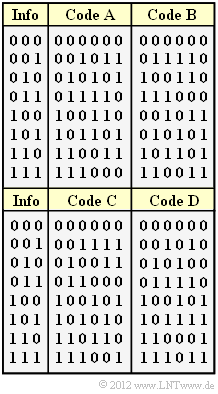Difference between revisions of "Aufgaben:Exercise 1.08Z: Equivalent Codes"
| Line 103: | Line 103: | ||
| − | [[Category:Aufgaben zu Kanalcodierung|^1.4 | + | [[Category:Aufgaben zu Kanalcodierung|^1.4 Beschreibung linearer Blockcodes |
^]] | ^]] | ||
Revision as of 14:48, 12 December 2017
In der Grafik sind die Zuordnungen $\underline{u} → \underline{x}$ für verschiedene Codes angegeben, die im Folgenden jeweils durch die Generatormatrix G und die Prüfmatrix H charakterisiert werden:
- $\color{red}{\boldsymbol{\rm Code \ A}}$:
- $${ \boldsymbol{\rm G}}_{\rm A} = \begin{pmatrix} 1 &0 &0 &1 &1 &0\\ 0 &1 &0 &1 &0 &1\\ 0 &0 &1 &0 &1 &1 \end{pmatrix} \hspace{0.05cm},$$
- $${ \boldsymbol{\rm H}}_{\rm A} = \begin{pmatrix} 1 &1 &0 &1 &0 &0\\ 1 &0 &1 &0 &1 &0\\ 0 &1 &1 &0 &0 &1 \end{pmatrix} \hspace{0.05cm}.$$
- $\color{red}{\boldsymbol{\rm Code \ B}}$:
- $${ \boldsymbol{\rm G}}_{\rm B} = \begin{pmatrix} 0 &0 &1 &0 &1 &1\\ 1 &0 &0 &1 &1 &0\\ 0 &1 &1 &1 &1 &0 \end{pmatrix} \hspace{0.05cm},$$
- $$ { \boldsymbol{\rm H}}_{\rm B} = \begin{pmatrix} 1 &0 &1 &0 &1 &0\\ 1 &1 &0 &1 &0 &0\\ 0 &1 &1 &0 &0 &1 \end{pmatrix} \hspace{0.05cm}.$$
- $\color{red}{\boldsymbol{\rm Code \ C}}$:
- $${ \boldsymbol{\rm G}}_{\rm C} = \begin{pmatrix} 1 &0 &0 &1 &0 &1\\ 0 &1 &0 &0 &1 &1\\ 0 &0 &1 &1 &1 &1 \end{pmatrix} \hspace{0.05cm},{ \boldsymbol{\rm H}}_{\rm C} = \begin{pmatrix} 1 &0 &1 &1 &0 &0\\ 0 &1 &1 &0 &1 &0\\ 1 &1 &1 &0 &0 &1 \end{pmatrix} \hspace{0.05cm},$$
- $\color{red}{\boldsymbol{\rm Code \ D}}$:
- $${ \boldsymbol{\rm G}}_{\rm D} = \begin{pmatrix} 1 &0 &0 &1 &0 &1\\ 0 &1 &0 &1 &0 &0\\ 0 &0 &1 &0 &1 &0 \end{pmatrix} \hspace{0.05cm},{ \boldsymbol{\rm H}}_{\rm D} = \begin{pmatrix} 1 &1 &0 &1 &0 &0\\ 0 &0 &1 &0 &1 &0\\ 1 &0 &0 &0 &0 &1 \end{pmatrix} \hspace{0.05cm}.$$
In dieser Aufgabe soll untersucht werden, welche dieser Codes bzw. Codepaare
- systematisch sind,
- identisch sind (das heißt: Verschiedene Codes haben gleiche Codeworte),
- äquivalent sind (das heißt: Verschiedene Codes haben gleiche Codeparameter).
Hinweis :
Die Aufgabe gehört zum Themengebiet von Kapitel Allgemeine Beschreibung linearer Blockcodes Anzumerken ist, dass die Angabe einer Prüfmatrix H nicht eindeutig ist. Verändert man die Reihenfolge der Prüfgleichungen, so entspricht dies einer Vertauschung von Zeilen.
Fragebogen
Musterlösung
- $$\underline{x} = ( x_1, x_2, x_3, x_4, x_5, x_6) = ( u_1, u_2, u_3, p_1, p_2, p_{3}) \hspace{0.05cm}.$$
Diese Bedingung erfüllen die Codes A, C und D ⇒ Antwort 1, 2, 4.
(2) Nur Code A und Code B sind identische Codes ⇒ Antwort 1. Sie beinhalten genau die gleichen Codeworte und unterscheiden sich nur durch andere Zuordnungen $\underline{u} → \underline{x}$. Wie in der Musterlösung zur Aufgabe A1.08 (3) angegeben, gelangt man von der Generatormatrix ${ \boldsymbol{\rm G}}_{\rm B}$ zur Generatormatrix ${ \boldsymbol{\rm G}}_{\rm A}$ allein durch Vertauschen/Permutieren von Zeilen oder durch Ersetzen einer Zeile durch die Linearkombination zwischen dieser Zeile und einer anderen.
(3) Code A und Code B sind mehr als äquivalent, nämlich identisch. Code C und D unterscheiden sich zum Beispiel auch durch die minimale Hamming–Distanz $d_{\rm min} = 3$ bzw. $d_{\rm min} = 2$ und sind somit auch nicht äquivalent.
Richtig ist somit allein Antwort 2. Code B und Code C haben gleiche Eigenschaften, beispielsweise gilt für beide $d_{\rm min} = 3$. Sie beinhalten aber andere Codeworte.
(4) Richtig ist Antwort 3:
- Die letzte Spalte von ${ \boldsymbol{\rm G}}_{\rm B}$ ergibt die erste Spalte von ${ \boldsymbol{\rm G}}_{\rm C}$.
- Die erste Spalte von ${ \boldsymbol{\rm G}}_{\rm B}$ ergibt die zweite Spalte von ${ \boldsymbol{\rm G}}_{\rm C}$.
- Die zweite Spalte von ${ \boldsymbol{\rm G}}_{\rm B}$ ergibt die dritte Spalte von ${ \boldsymbol{\rm G}}_{\rm C}$, usw.
(5) Die Bedingung ${ \boldsymbol{\rm H}} · { \boldsymbol{\rm G}}^{\rm T} = \boldsymbol{0}$ gilt für alle linearen Codes ⇒ Alle Aussagen treffen zu.
